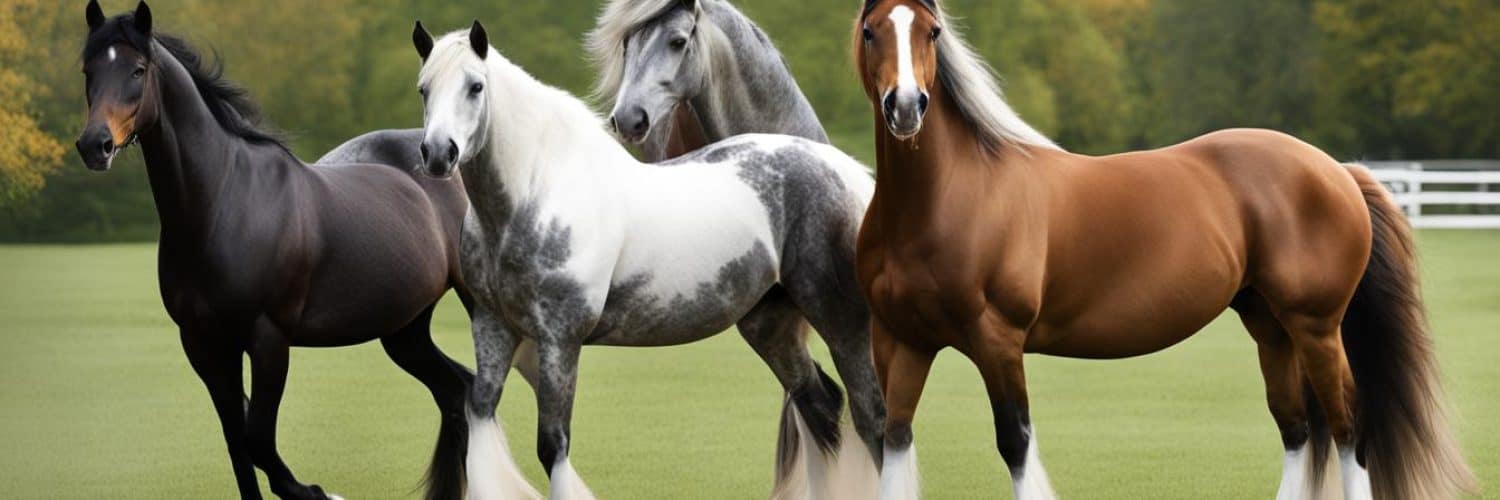Explore the grace and beauty of mares, uncover equestrian insights, and learn essential tips on horse care, training, and health tailored for these equine gems. Mares are a fascinating subject in the world of horses. From their historical significance to their role in various equestrian disciplines, mares hold a special place in the hearts of horse enthusiasts. In this article, we will delve into the rich history of mares and explore their impact on horseback riding, horse care, and horse training.
Key Takeaways:
- Discover the grace and beauty of mares in the world of horses.
- Learn insights into equestrian practices, horse care, training, and health specifically for mares.
- Uncover the rich history of mares and their impact on horseback riding and equestrian sports.
- Explore the rise of mare’s milk as a potential health drink.
- Gain essential tips for horse care and training, tailored for mares.
The Influence of King Henry VIII on Dressage in England
King Henry VIII, the notorious English monarch, is known for many things, but his contribution to the world of dressage is often overlooked. It is believed that King Henry VIII brought dressage to England during his reign in the 16th century. He was an avid horseman and had a passion for classical dressage. Through his interactions with Italian riding masters and the introduction of classical dressage horses to England, King Henry VIII set the foundation for dressage training in the country. His love for horses and dedication to training techniques that emphasized kindness over punishment paved the way for the development of dressage as we know it today.
Dressage is an intricate form of horse training that focuses on precision, harmony, and communication between the horse and rider. It is often referred to as “the ballet of horseback riding” and is characterized by a series of movements and exercises that showcase the horse’s athleticism and obedience. Dressage has become a popular equestrian discipline worldwide, with competitions held at various levels, from local shows to international events like the Olympics.
Classical Dressage: A Legacy of King Henry VIII
King Henry VIII’s influence on dressage in England can be traced back to his fascination with equestrian pursuits. He surrounded himself with skilled horsemen from Italy, who introduced him to the principles of classical dressage. These principles emphasized the partnership between horse and rider, focusing on lightness, balance, and harmony in every movement.
Through his patronage and passion for dressage, King Henry VIII established a culture of equestrian excellence and innovation that continues to thrive in England. His love for English horses and his commitment to their training laid the groundwork for the development of dressage techniques that are still practiced today.
“Dressage is the highest expression of horse training. It is a dialogue between two souls: the horse and the rider.”
The Importance of Dressage in Horse Training
Dressage is not only a competitive sport but also a fundamental aspect of horse training. The principles and movements of dressage enhance the horse’s physical and mental well-being, developing their strength, flexibility, and attentiveness. Through consistent training and practice, dressage horses become supple, obedient, and responsive.
English horses, bred for their athleticism and temperament, are well-suited for dressage training. The skills and techniques passed down from King Henry VIII’s era continue to shape the foundation of dressage training in England today.
Dressage Movements and Training Techniques
The training of a dressage horse involves a progressive series of movements and exercises designed to develop their physical abilities and refine their responses to the rider’s aids. These movements include the passage, piaffe, half-pass, extended trot, and collected canter, among others.
Table: Dressage Movements
| Movement | Description |
|---|---|
| Passage | A highly collected trot with an elevated and suspended stride. |
| Piaffe | A highly collected, elevated trot in place. |
| Half-Pass | A lateral movement where the horse moves diagonally across the arena. |
| Extended Trot | A powerful and ground-covering trot with maximum stride length. |
| Collected Canter | A slow, controlled canter with increased engagement and collection. |
These movements require precise communication between the horse and rider, showcasing the horse’s training, obedience, and athleticism.
King Henry VIII’s legacy lives on in the world of dressage. His influence on English dressage and his commitment to horse training techniques have shaped the discipline into what it is today. From the rolling hills of England to the competition arenas across the world, dressage continues to captivate horse enthusiasts and showcase the remarkable partnership between man and horse.
Understanding Horse Behavior and Training Methods
When it comes to training horses, understanding their behavior is crucial for successful outcomes. Horses have their unique ways of perceiving and interacting with the world, which differ from human perspectives. Therefore, it is important to avoid labeling their behavior based on human standards to avoid misunderstandings and ineffective training methods.
Instead of resorting to punishment or force, establishing mutual respect and communication with horses should be the foundation of any training program. By listening to horses and addressing their needs and anxieties, trainers can build trust and rapport, leading to better results in the training process.
Rather than focusing on dominance and submission, fair training methods emphasize the importance of mutual understanding and collaboration between trainers and horses. This approach creates an environment where both parties learn from each other, fostering a harmonious partnership based on trust and respect.
By recognizing and appreciating the natural behavior of horses, trainers can tailor their techniques to cater to their unique needs and preferences. This personalized approach helps create a positive and enjoyable training experience, resulting in a well-trained horse that is eager to work alongside its handler.
| Horse Behavior | Training Methods |
|---|---|
| Horses have instinctual flight responses and are sensitive to their environment. | Use desensitization exercises to gradually introduce horses to potentially frightening stimuli. |
| Horses rely on non-verbal communication such as body language and tone of voice. | Be aware of your own body language and use clear, consistent cues to communicate with your horse. |
| Horses thrive on routine and predictability. | Establish a consistent training schedule to provide structure and security for your horse. |
| Horses learn through repetition and rewards. | Use positive reinforcement, such as treats or praise, to reward desired behaviors. |
| Horses have individual personalities and preferences. | Adapt your training methods to suit the needs of each horse, recognizing their unique qualities. |
Note: To truly understand horse behavior and training methods, it is advisable to seek guidance from experienced professionals or certified trainers who specialize in equine behavior and training.
The Rise of Mare’s Milk as a Health Drink
While cow’s milk has long been a popular choice for dairy consumption, mare’s milk is gaining attention as a potential health drink. In Central Asia, mare’s milk has been a traditional staple, often fermented into the drink called koumiss. It is believed to have curative properties and has been used as a treatment for tuberculosis. In Europe, mare’s milk remains a niche product, but its reputation as a health elixir is causing trouble for producers due to regulatory constraints.
Mare’s milk is high in vitamin C and iron, low in fat, and has levels of lactose and casein similar to human breast milk. Studies suggest it may have benefits for skin conditions and digestive problems, and some customers swear by its positive effects. However, more research is needed to fully understand the potential health benefits of mare’s milk.
Health Benefits of Mare’s Milk
Here are some of the potential health benefits associated with mare’s milk:
- Rich in Vitamin C and Iron: Mare’s milk contains higher levels of vitamin C and iron compared to cow’s milk, making it a potential nutritional powerhouse.
- Low in Fat: With its low-fat content, mare’s milk can be a suitable alternative for those looking for a lighter dairy option.
- Potential Digestive Benefits: Some studies suggest that mare’s milk may aid in digestion and help alleviate digestive issues such as constipation or bloating.
- Possible Skin Benefits: The natural properties of mare’s milk may contribute to healthier skin, potentially helping with conditions like eczema or psoriasis.
- Suitable for Lactose Intolerance: Mare’s milk has lower levels of lactose compared to cow’s milk, making it a potential alternative for individuals with lactose intolerance.
More research is needed to fully understand the potential health benefits of mare’s milk, but early studies and anecdotal evidence indicate that it could be a valuable addition to a healthy diet.
Despite the potential benefits, mare’s milk still faces obstacles due to regulations and limited availability. Let’s delve deeper into the challenges faced by mare’s milk producers in the next section.
The Challenges of Mare’s Milk Production
Producing mare’s milk poses various challenges for mare’s milk producers, especially due to strict regulations imposed by the European Union (EU) and limited resources within the industry. Currently, there are approximately 30 mare’s milk producers in Germany, with scattered production across other European countries. However, the industry lacks strong support from national associations or a pan-European organization, making it more difficult for producers to overcome the obstacles they face.
One of the significant challenges for mare’s milk producers is complying with EU regulations. These regulations ensure the quality and safety of mare’s milk through stringent production and testing requirements. While these regulations are essential for consumer protection, they also limit the ability of producers to make specific nutritional claims or promote the potential health benefits of mare’s milk. This restriction hampers their ability to market the product effectively and educate consumers about its unique properties.
“We are passionate about producing high-quality mare’s milk and believe that it has significant health benefits. However, the regulations make it challenging for us to communicate these advantages to potential customers,” says Anna Müller, a mare’s milk producer in Germany.
Despite these challenges, mare’s milk producers remain dedicated to their product and are actively working towards gaining official approval and recognition for mare’s milk as a health drink. They are advocating for changes in EU regulations that would allow them to make nutritional claims and promote the potential health benefits of mare’s milk. Additionally, mare’s milk producers are exploring partnerships and collaborations to enhance the visibility and market reach of their products.
Potential Solutions
To address the challenges faced by mare’s milk producers, the following solutions can be considered:
- Establishment of a pan-European organization or network dedicated to supporting mare’s milk producers, facilitating knowledge exchange, and providing resources for research and development.
- Collaboration between mare’s milk producers, researchers, and regulatory authorities to conduct comprehensive scientific studies that validate the potential health benefits of mare’s milk. These studies can be used as evidence to support regulatory changes.
- Advocacy efforts, both at the national and international levels, to raise awareness about mare’s milk and its unique properties. This can involve engaging with policymakers, healthcare professionals, and consumers to promote the value of mare’s milk as a health drink.
By addressing these challenges and implementing solutions, mare’s milk producers can overcome the regulatory limitations and further develop the mare’s milk industry, ultimately providing consumers with a greater understanding of the benefits and expanding the market for this unique and nutritious beverage.
| Challenges | Solutions |
|---|---|
| Strict EU regulations limit nutritional claims and marketing opportunities | Advocate for regulatory changes and work towards official approval of mare’s milk as a health drink |
| Lack of strong support from national associations or pan-European organizations | Establish a pan-European organization or network to provide support, resources, and knowledge exchange |
| Need for scientific studies that validate the potential health benefits of mare’s milk | Collaborate with researchers and regulatory authorities to conduct comprehensive scientific studies |
| Limited market reach and visibility | Engage in advocacy efforts to raise awareness among policymakers, healthcare professionals, and consumers |
The Future of Mare’s Milk Industry
The mare’s milk industry is at a turning point, with potential changes on the horizon. The European Parliament has voted to formulate guidelines for standards and inspections at European horse and donkey dairies, which could raise awareness of mare’s milk and increase sales. Producers are advocating for more scientific studies to be conducted to validate the potential health benefits of mare’s milk. However, conducting such studies is expensive, and the industry lacks the financial support to undertake them. In the meantime, producers are working within the constraints of existing regulations and exploring partnerships to further develop the mare’s milk market worldwide.
| Challenges | Solutions |
|---|---|
| Limited financial resources for scientific studies | Seeking funding through partnerships and grants |
| Strict European regulations on mare’s milk production | Adhering to regulations while advocating for reasonable changes |
| Lack of awareness and market demand | Engaging in marketing and educational campaigns |
| Limited industry support and collaboration | Establishing national and pan-European associations |
The Importance of Scientific Studies
Scientific studies play a crucial role in validating the potential health benefits of mare’s milk. While anecdotal evidence and traditional use have sparked interest in mare’s milk as a health drink, scientific research is essential for gaining broader acceptance and recognition. These studies can provide concrete evidence of the nutritional value and therapeutic properties of mare’s milk, allowing consumers to make informed choices and giving producers a solid foundation for promoting their products.
“Scientific studies are vital in unlocking the true potential of mare’s milk as a health drink. By conducting rigorous research, we can gain a deeper understanding of its benefits and ensure its place in the dairy market.” – Dr. Maria Schmidt, Researcher at the Institute of Food Science
Exploring New Frontiers
Despite the challenges, producers in the mare’s milk industry remain optimistic about the future. They are actively seeking collaborations and partnerships with research institutions and exploring innovative ways to overcome financial constraints. By working together and sharing resources, the industry can pave the way for new opportunities and advancements in mare’s milk production.
In conclusion, the mare’s milk industry is at a critical juncture, with regulatory changes and the need for scientific validation shaping its future. Producers are determined to navigate these challenges and continue promoting the potential health benefits of mare’s milk. With increased awareness, research, and collaboration, the mare’s milk industry has the potential to flourish and offer consumers a unique and valuable dairy alternative.
The Rich History of Mares in Equestrian Sports
Mares have played a significant role in the world of equestrian sports, leaving a lasting impression throughout history. These elegant equines have showcased their remarkable talent, athleticism, and grace in various disciplines, from thrilling racing events to sophisticated dressage performances. Countless famous mares have risen to prominence, becoming icons in the equestrian world and captivating audiences with their exceptional abilities.
Mares possess unique qualities and abilities that make them sought-after partners for riders and competitors alike. Their speed and agility have made them dominant forces in the racing industry, while their precision and elegance have elevated them to the pinnacle of dressage. These stunning horse breeds have not only contributed to the development of equestrian sports but have also left an indelible mark on its rich history.
Icons of Equestrian Sports
“Mares have a special place in the hearts of horse enthusiasts, as they continue to push the boundaries of what is possible in the world of equestrian sports.” – Equestrian Magazine
Throughout time, mares have proven their mettle on the racetrack, with legendary Thoroughbreds like Zenyatta and Rachel Alexandra captivating audiences and setting new records. In the realm of dressage, mares such as Isabell Werth’s Bella Rose and Charlotte Dujardin’s Valegro have mesmerized spectators and secured their place in the annals of equestrian history.
Beyond racing and dressage, mares have excelled in a wide range of other equestrian disciplines, including show jumping, eventing, and reining. Their versatility and natural athleticism have made them formidable competitors in these highly demanding sports.
Mare Breeds in Equestrian Sports
Various horse breeds have produced exceptional mares that have left an indelible mark on equestrian sports. Here are some notable examples:
| Breed | Notable Mare | Discipline |
|---|---|---|
| Thoroughbred | Zenyatta | Thoroughbred Racing |
| Hanoverian | Bella Rose | Dressage |
| British Warmblood | Valegro | Dressage |
| Arabian | Estasha | Endurance Riding |
| American Quarter Horse | Shining Spark | Reining |
These are just a few examples of the remarkable mares that have left their hoofprints on the world of equestrian sports. The unyielding spirit, athleticism, and grace of mares continue to shape and define the sport, inspiring riders, trainers, and enthusiasts worldwide.
Tips for Horse Care and Training for Mares
When it comes to caring for and training mares, it’s important to consider their unique needs and behaviors compared to their male counterparts. By providing proper nutrition, regular exercise, and a comfortable living environment, you can ensure their overall well-being.
Mares, just like people, have individual personalities and preferences. It’s essential to adapt training techniques to suit their specific needs. By establishing a trusting relationship and using training methods that are fair and respectful, you can foster a positive learning environment for your mare.
Proper Nutrition
One of the key aspects of horse care is providing a balanced diet. Mares require a diet rich in nutrients to support their overall health and well-being. Consult with a veterinarian or equine nutritionist to determine the appropriate feeding regimen for your mare, taking into account her age, activity level, and any specific dietary needs she may have.
Remember, a well-fed mare is a happy and healthy mare.
Regular Exercise
Exercise is essential for maintaining the overall fitness and mental well-being of your mare. Engage her in regular physical activities such as riding, longeing, or turn-out time in a paddock. This helps to stimulate her mind, release excess energy, and maintain muscle tone and flexibility. Just like humans, horses thrive when they have a regular exercise routine.
Comfortable Living Environment
Creating a comfortable living environment is crucial for your mare’s happiness and overall health. Ensure she has access to clean water, ample space to move around, and a comfortable, well-bedded stall or shelter. Additionally, regular grooming and hoof care are essential to maintain her hygiene and prevent any discomfort or health issues.
Building a Trusting Relationship
Building trust with your mare is the foundation for successful training. Take the time to understand her body language and communication cues and respond to them appropriately. Positive reinforcement, such as rewards and praise, can go a long way in building a bond of trust and cooperation with your mare.
Adapting Training Techniques
Each mare is unique, and what works for one may not work for another. It’s important to adapt your training techniques to suit your mare’s individual needs and preferences. Be patient, consistent, and use methods that prioritize fairness and kindness over force or punishment. This approach will help to maximize her learning potential and create a positive training experience for both of you.
Conclusion
Throughout history, mares have left an indelible mark on the world of horses. From their role in equestrian sports to their potential health benefits, these elegant equines continue to fascinate and captivate horse enthusiasts worldwide.
Understanding the behavior of mares is crucial for their care and training. By providing them with proper nutrition, exercise, and a comfortable living environment, we can ensure their overall well-being. When it comes to training, it is important to establish a trusting relationship and use fair and respectful methods tailored to each individual mare’s needs and preferences.
Furthermore, the unique qualities of mare’s milk have sparked interest in its potential as a health drink. Although more research is needed, mare’s milk is known for its high vitamin C and iron content, low fat levels, and similarities to human breast milk in lactose and casein composition. This underexplored elixir may hold promising benefits for skin conditions and digestive problems.
Whether you’re a horse lover, a rider, or simply curious about the world of horses, mares offer a fascinating journey into the equestrian realm. By acknowledging their historical significance, adopting proper care and training practices, and exploring the potential of mare’s milk, we can continue to appreciate and celebrate these magnificent creatures.
FAQ
Why are mares considered elegant equines?
Mares are considered elegant equines due to their grace and beauty. They possess unique qualities and abilities that make them highly sought-after in the world of horses.
What was King Henry VIII’s contribution to dressage?
King Henry VIII introduced dressage to England during his reign in the 16th century. His passion for classical dressage and interactions with Italian riding masters laid the foundation for dressage training in the country.
How should horses be trained?
Horses should be trained with respect, fairness, and an understanding of their behavior. Instead of using punishment or force, establishing mutual respect and clear communication is crucial for effective training.
What are the potential health benefits of mare’s milk?
Mare’s milk is believed to have curative properties and is high in vitamin C and iron. It may have benefits for skin conditions and digestive problems, but more research is needed to fully understand its potential health benefits.
What challenges do mare’s milk producers face?
Mare’s milk producers face challenges in terms of strict regulations, limited financial support, and constraints on making nutritional claims or promoting the potential health benefits of mare’s milk.
What is the future of the mare’s milk industry?
The mare’s milk industry is working towards gaining official recognition and approval as a health drink. Producers are advocating for more scientific studies and exploring partnerships to develop the market worldwide.
What role have mares played in equestrian sports?
Mares have played a significant role in various equestrian sports throughout history, showcasing their talent, athleticism, and grace. Many famous mares have achieved great success and become icons in the world of equestrian sports.
What are some mare-specific tips for horse care and training?
When caring for and training mares, it is important to provide proper nutrition, regular exercise, and a comfortable living environment. Establishing a trusting relationship and adapting training techniques to suit each mare’s individual needs are also crucial.
Why are mares admired in the world of horses?
Mares are admired in the world of horses for their historical significance, their role in equestrian sports, and the potential health benefits of mare’s milk. They offer a fascinating journey into the equestrian realm for horse lovers, riders, and enthusiasts.


















Add comment